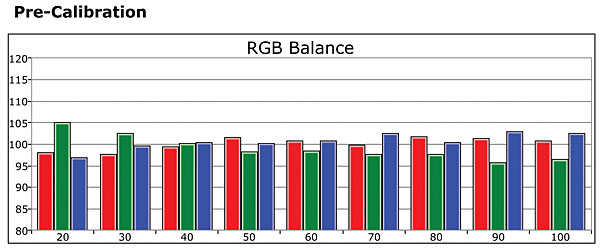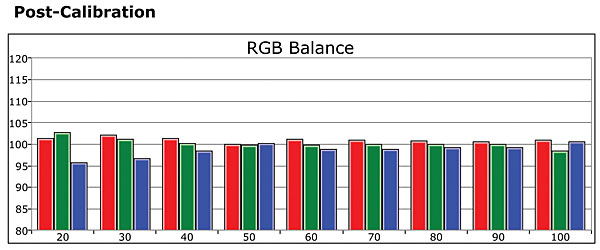Panasonic TC-P65ZT60 3D Plasma HDTV Test Bench
Full-On/Full-Off Contrast Ratio: 30,000:1
All measurements were performed in the Professional2 picture mode for 2D and the Custom (3D) mode for 3D, through an HDMI input with the set adjusted for a darkened room. The peak white level to achieve the measured contrast ratio was just over 33 foot-lamberts, and the black level 0.0011 ft-L. (The full-on/full-off contrast ratio measured on the Pioneer PRO-141FD Kuro for the comparisons in this test was 22,400:1 with peak white 33.6 ft-L, black level 0.0015 ft-L.)


The pre-calibration RGB Balance shown in the chart was taken in the THX Cinema mode, adjusted for approximately the same peak white level mentioned above with the Color temp. control set to Warm1. Gray scale Delta E values in this mode averaged an excellent 2.7; post-calibration. With the Warm 2 Color temp. setting used as the baseline, the Delta E averaged 0.71, with a high of 1.89 at 100 percent brightness. (Delta E is a figure of merit that indicates how closely a display adheres to the Rec. 709 HD color standard. Experts generally agree that levels below 3 are visibly indistinguishable from perfect color tracking.)
In the Rec. 709 Color Gamut setting, the color point’s pre-calibration color Delta E averaged a respectable 2.47. After calibration, it averaged an exceptional 0.43. Post-calibration, the average measured gamma across the full brightness range was 2.35, achieved from a baseline setting of 2.4 with minor tweaking of the Gamma Detail adjustments.
The best 3D option pre-calibration was the THX3D Cinema mode, with the Color temp. control set to Warm1. In this mode, the average Delta E for gray scale was 3.74, the average color Delta E 2.70, and the average gamma 1.97. Peak brightness through 3D glasses was 5.16 ft-L. Post-calibration in the 3D Custom mode, with Warm1 used as the calibration baseline, the average Delta E for gray scale was 0.53, the average color gamut Delta E was 1.06, the average gamma was 1.82 (with a low of 0.81 at 90 percent), and peak brightness through the glasses was 5.27 ft-L. It’s now common practice for manufacturers to pump up the subjective 3D brightness level by using low gammas. The best gamma selection depended on the source; either 2.2 or 2.4 worked best.
The TC-P65ZT60 passed all our standard video processing tests except for the 2:2 cadence tests for HD and SD, common and largely inconsequential failures.—TJN











































